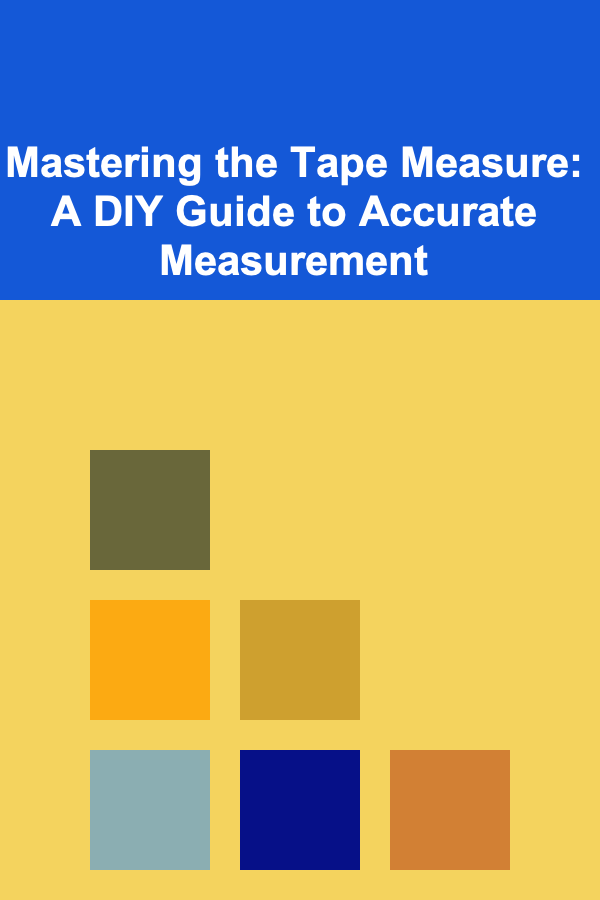
Mastering the Tape Measure: A DIY Guide to Accurate Measurement
ebook include PDF & Audio bundle (Micro Guide)
$12.99$11.99
Limited Time Offer! Order within the next:

The tape measure is arguably the most fundamental tool in any DIY enthusiast's arsenal. Whether you're building a deck, hanging shelves, or crafting a birdhouse, accurate measurements are crucial for a successful project. A seemingly simple task, measuring with a tape measure correctly requires understanding its features, applying consistent techniques, and avoiding common pitfalls. This guide will delve deep into the art of accurate measurement, equipping you with the knowledge and skills to confidently tackle any DIY project.
Understanding Your Tape Measure
Before you even begin to measure, it's essential to familiarize yourself with the anatomy and nuances of your tape measure. Not all tape measures are created equal, and understanding their specific features will significantly improve your accuracy.
The Hook (End Hook or Tang)
The hook at the end of the tape measure is designed to move slightly. This movement, equal to the thickness of the hook itself, is crucial for accurate inside and outside measurements. When taking an outside measurement, the hook extends outward, allowing you to butt it against the edge of the object. When taking an inside measurement, the hook retracts slightly, compensating for its own thickness. Never force the hook or attempt to fix it if it feels loose; this movement is intentional. A damaged or altered hook will invalidate your measurements.
The Tape
The tape itself is typically made of steel, coated with a protective layer to prevent rust and wear. However, even with protection, the tape can become damaged or distorted over time, especially if subjected to harsh conditions or improper handling. Regularly inspect the tape for kinks, bends, or breaks. A damaged tape measure should be replaced to ensure accuracy.
The markings on the tape are usually in inches and feet, with fractional increments representing smaller units. Pay close attention to the scale you're using. Often, the first foot is marked with smaller, more detailed increments, such as 1/16 inch or even 1/32 inch, for greater precision. Beyond the first foot, the markings typically become coarser, usually to 1/8 inch or 1/4 inch increments.
The Case
The case provides protection for the tape and often includes a locking mechanism to hold the tape in place. Some tape measures also have a belt clip for convenience. The bottom of the case is often designed to be relatively flat, allowing you to rest it against a surface for stable inside measurements. Some high-end tape measures even have a digital display that shows the measurement directly from the case base to the end of the tape, eliminating the need to manually add the case length.
Accuracy Standards
Tape measures are manufactured to varying accuracy standards. Look for markings on the tape measure or its packaging that indicate its accuracy class. Higher accuracy classes provide tighter tolerances and are essential for projects requiring extreme precision. While a standard tape measure is sufficient for most DIY tasks, consider investing in a higher-grade instrument for critical applications.
Essential Techniques for Accurate Measurement
Having a good tape measure is only half the battle. Mastering the techniques for using it correctly is equally important. Here are some fundamental techniques to ensure accurate measurements:
Holding the Tape Measure Correctly
How you hold the tape measure significantly affects the accuracy of your measurements. For outside measurements, ensure the hook is securely butted against the edge of the object, and hold the tape taut but not stretched. Apply consistent pressure to avoid introducing variations in the measurement. For inside measurements, press the case firmly against one surface while extending the tape to the opposite surface. Again, maintain consistent pressure and ensure the case remains perpendicular to the surface.
Reading the Tape Measure Accurately
Reading the tape measure correctly requires careful attention to detail. Identify the nearest whole inch mark and then count the fractional increments. Be particularly careful when reading measurements near the end of the tape, where the markings can be closely spaced. If you are having difficulty reading the markings due to poor eyesight, consider using a magnifying glass or purchasing a tape measure with larger, easier-to-read markings. Avoid parallax error by ensuring you are looking directly perpendicular to the tape at the point of measurement.
Dealing with Fractions
Many DIY projects require working with fractional measurements. Understanding how to add, subtract, and convert fractions is crucial. When adding or subtracting fractions, you need to find a common denominator. For example, to add 1/2 inch and 1/4 inch, you would convert 1/2 inch to 2/4 inch and then add it to 1/4 inch, resulting in 3/4 inch. Familiarize yourself with common fractional equivalents (e.g., 1/2 = 4/8 = 8/16) to simplify calculations. Many online calculators and mobile apps can assist with fraction calculations, but understanding the underlying principles is essential.
Measuring Long Distances
Measuring long distances with a standard tape measure can be challenging. When measuring distances longer than the tape measure's length, use a technique called "leapfrogging." Measure out the full length of the tape measure, mark the endpoint, and then reposition the tape measure with the hook at the mark. Repeat this process until you reach the desired distance. Ensure that each measurement is taken in a straight line and that the tape measure is held taut and level. For very long distances, consider using a laser distance measurer, which can provide accurate measurements quickly and easily.
Measuring Around Curves
Measuring around curves requires a flexible measuring tool. A flexible tape measure, also known as a tailor's tape, is ideal for this purpose. Alternatively, you can use a string or flexible wire to trace the curve, and then measure the length of the string or wire. For complex curves, consider using a profile gauge to capture the shape and then transfer it to your material.
Tip: Using a Helper
For long or awkward measurements, having a helper can significantly improve accuracy. One person can hold the hook end of the tape measure while the other person reads the measurement. This helps ensure the tape remains taut and aligned correctly.
Common Mistakes to Avoid
Even experienced DIYers can fall victim to common measurement mistakes. Being aware of these pitfalls will help you avoid costly errors:
Not Accounting for the Hook
As mentioned earlier, the hook on the end of the tape measure is designed to move. Failing to account for this movement when taking inside or outside measurements is a common mistake. Always ensure the hook is properly positioned and that you understand how its movement affects the overall measurement.
Reading the Wrong Scale
Tape measures typically have multiple scales, including inches, feet, and sometimes metric units. Carefully check which scale you are using before taking a measurement. Misreading the scale can lead to significant errors in your project.
Bending or Kinking the Tape
Bending or kinking the tape measure can distort the measurement, especially over long distances. Avoid sharp bends and ensure the tape is held taut and straight. If the tape becomes kinked, try to straighten it carefully before taking a measurement.
Parallax Error
Parallax error occurs when you read the tape measure from an angle. This can cause you to misread the measurement by a small amount. To avoid parallax error, ensure you are looking directly perpendicular to the tape at the point of measurement.
Assuming All Surfaces Are Perfectly Flat
In reality, few surfaces are perfectly flat. When measuring for cuts, especially in woodworking, always measure multiple points along the cut line to account for any variations in the surface. If necessary, use a straightedge or level to ensure the cut is straight and accurate.
Not Double-Checking Measurements
It's always a good idea to double-check your measurements before making any cuts or proceeding with your project. A simple mistake in measurement can lead to wasted materials and frustration. Taking the time to double-check can save you time and money in the long run.
Warning: Safety First
Always be careful when using a tape measure, especially around sharp objects or power tools. Avoid extending the tape measure too far, as it can snap back quickly and cause injury. Wear appropriate safety glasses to protect your eyes from flying debris.
Choosing the Right Tape Measure for the Job
Selecting the right tape measure for the specific task is crucial. Different projects demand different levels of accuracy, length, and durability.
Tape Length
Consider the maximum length you'll need for your projects. Standard tape measures range from 12 feet to 35 feet or more. For most DIY projects around the home, a 25-foot tape measure is usually sufficient. However, for larger projects like building a deck or fencing, you may need a longer tape measure.
Tape Width
A wider tape measure blade is generally more rigid and easier to extend over long distances without bending or kinking. This is especially important for outdoor projects where you may be working without a helper. However, a wider tape measure may be bulkier and less convenient for smaller, more detailed tasks.
Blade Material and Coating
The blade material and coating affect the tape measure's durability and resistance to wear and tear. Steel blades are the most common, but they can be susceptible to rust if not properly coated. Look for tape measures with a durable coating, such as nylon or polymer, to protect the blade from damage and corrosion.
Case Material
The case material also contributes to the tape measure's overall durability. ABS plastic is a common choice for its impact resistance, but more durable materials like metal or reinforced composites are available for heavy-duty use.
Features
Consider the features that are important to you. Some tape measures have magnetic hooks for easy attachment to metal surfaces, while others have digital displays for quick and accurate readings. A locking mechanism is essential for holding the tape in place while you mark your measurements. A belt clip can also be a convenient feature for keeping the tape measure readily accessible.
Specialty Tape Measures
For specific applications, consider using specialty tape measures. For example, a laser distance measurer is ideal for measuring long distances quickly and accurately. A flexible tape measure is perfect for measuring around curves. A measuring wheel is useful for measuring large areas like lawns or fields.
Advanced Techniques for Precision Measurement
For projects requiring extreme accuracy, consider using these advanced techniques:
Using a Combination Square
A combination square is a versatile tool that can be used for a variety of measurement and layout tasks. It can be used to measure angles, mark lines, and check for squareness. When used in conjunction with a tape measure, it can help you achieve more precise measurements and ensure that your cuts are accurate.
Using Calipers
Calipers are precision measuring instruments that can be used to measure internal and external dimensions with a high degree of accuracy. They are particularly useful for measuring small objects or distances that are difficult to measure with a tape measure. Digital calipers offer even greater precision and ease of use.
Using a Laser Level
A laser level projects a precise horizontal or vertical line, which can be used to ensure that your measurements are level and aligned correctly. This is especially important for projects like hanging shelves, installing cabinets, or building a deck.
Temperature Considerations
Temperature can affect the length of a tape measure blade. Extreme temperatures can cause the blade to expand or contract slightly, which can introduce errors in your measurements. For critical applications, try to take measurements at a consistent temperature or compensate for temperature variations.
Maintaining Your Tape Measure
Proper maintenance will extend the life of your tape measure and ensure its accuracy for years to come.
Cleaning the Tape
Regularly clean the tape measure blade to remove dirt, dust, and debris. Use a soft cloth or brush to wipe down the blade. Avoid using harsh chemicals or abrasive cleaners, which can damage the blade or coating.
Protecting from Moisture
Moisture can cause the tape measure blade to rust. Store your tape measure in a dry place and avoid exposing it to excessive moisture. If the tape measure gets wet, dry it thoroughly before storing it.
Avoiding Dropping
Dropping the tape measure can damage the case or blade, affecting its accuracy. Be careful when handling the tape measure and avoid dropping it on hard surfaces.
Replacing Damaged Parts
If any parts of the tape measure become damaged, such as the hook or blade, replace them as soon as possible. Continuing to use a damaged tape measure can lead to inaccurate measurements and potentially dangerous situations.
Conclusion
Mastering the art of accurate measurement with a tape measure is a fundamental skill for any DIY enthusiast. By understanding the features of your tape measure, applying consistent techniques, avoiding common mistakes, and choosing the right tape measure for the job, you can significantly improve the accuracy of your projects and achieve professional-quality results. Practice these techniques regularly, and soon you'll be measuring with confidence and precision.

How to Keep Pet Medications Organized and Accessible
Read More
How to Make a Checklist for Reducing Customer Onboarding Time
Read More
How to Prepare a Budget for Your Side Hustle
Read More
How to Set Up and Maintain an Investment Portfolio
Read More
How to Store Your Clothes Efficiently Without Taking Up Space
Read More
How To Play the Clarinet: Your First Notes
Read MoreOther Products

How to Keep Pet Medications Organized and Accessible
Read More
How to Make a Checklist for Reducing Customer Onboarding Time
Read More
How to Prepare a Budget for Your Side Hustle
Read More
How to Set Up and Maintain an Investment Portfolio
Read More
How to Store Your Clothes Efficiently Without Taking Up Space
Read More